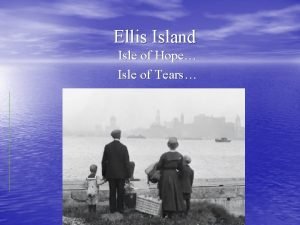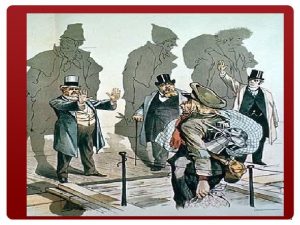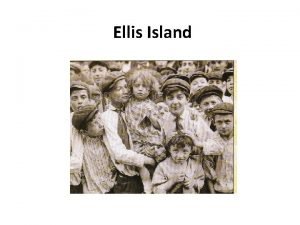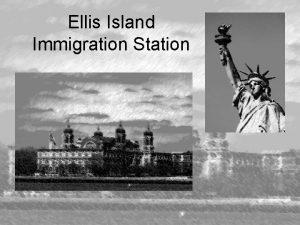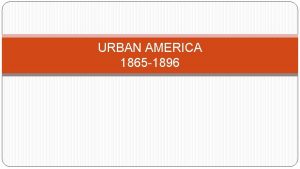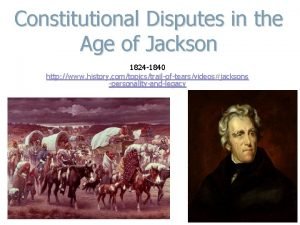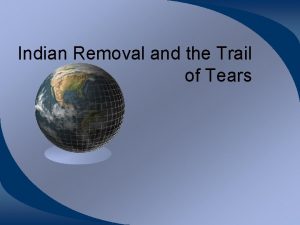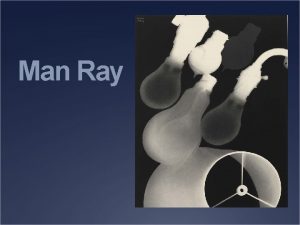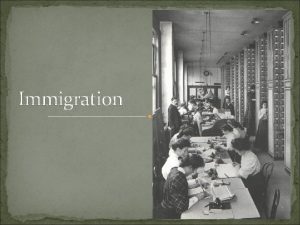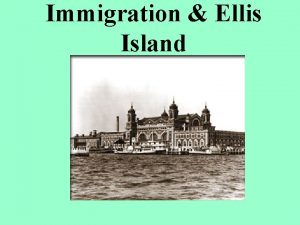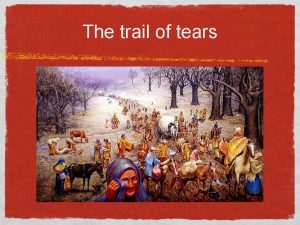Ellis Island Isle of Hope Isle of Tears






























- Slides: 30

Ellis Island Isle of Hope… Isle of Tears…

Ellis Island – New York Harbor Top – Island #1: Main buildings for checkin procedures Middle – Island #2: Hospital facilities Lower- Island #3: Hospital wards

From 1892 to 1954, this immigrant depot processed the greatest tide of incoming humanity in the nation’s history. Nearly twelve million landed here in their search of freedom of speech and religion, and for economic opportunity.

Push – Pull Factors Push Factors: • Famine • Lack of Jobs • Political Freedom • War Pull Factors: • Free Land • Job Opportunities • Freedoms

The Journey • Usually it took a few • • • weeks, but could take up to a couple of months Dangerous Poor conditions on the ship Cost for a 3 rd class ticket was $12. 00 in 1890 ($150 today)

What did they bring with them? “What did we take with us? Our clothes, our pillows, our big thick comforters made from pure goose feathers – not chicken feathers, our bibles, and a barrel of pickles” - Fannie Shoock, a Polish Jewish immigrant in 1927

What class are you? • When the ships would dock at Ellis Island: 1 st and 2 nd class passengers were “lightly” inspected on the ship and, if free of disease, were allowed to go ashore in America immediately. 3 rd class (steerage) who paid the lowest fares were taken to Ellis Island for processing.

The Process of Entry

Let the wait begin… • The entire process • would take between 6 -8 hours of standing in line barring no setbacks! 700 employees would see an average of 5, 000 people pass through this room in ONE DAY!

Why was the process so hard? America wanted: Good citizens Good workers Healthy people NOT: “criminals, political radicals, people who might become a public charge, those with illnesses”

Medical Requirements • Exams began as soon • • • as the people got off the boat! They would look for obvious signs of illness (fatigue, rashes) Stairs with luggage were first Walking - posture

Physical Exams • Took about 1 hour if • • • nothing was wrong Doctors would look over immigrants (eyes, hair, heart, etc) The process was scary for immigrants Would be pulled out of line for further exams if needed

Further Evaluations • Letters would be • • • written on the coats of people - codes Families separated Hospitalization if needed Could be rejected and sent back to old country if disease wasn’t curable (1% turned away for medical reasons)

Hospitals on Ellis Island • Different wards for different diseases: Contagious diseases (trachoma, favius, etc) Non-contagious (heart failure, pregnancy, hernias, etc) • Doctors and nurses would live in the hospitals for weeks at a time • No contact with outside world • Patients could only have visitors if they were dying.

Sick kids… • Parents couldn’t see their • kids until they were released. They would have to go to New York, then come back to get them. 11 yrs old = key age (If a child was 11 and rejected a parent had to return to the old country with them, if over 11 they could send them back by themselves)

Psychological Exams • If a person was thought • • • to be mentally ill they would mark them with a “X” (9%) were marked with an initial “X” on their coats They would undergo mental testing Mental illness was cause for rejection

Further Questioning –Legal Inspection • After medical, the immigrants would be questioned… Are you married or single? What is your occupation? How much money do you have? Have you been convicted of a crime? Manifest sheets filled out on the steamships contained information and were given to the officials at Ellis Island for helping to process the immigrants Literacy test required – 40 word passage in English

The right to Appeal! • If a person was rejected, • • • they had the right to appeal. They would testify and be allowed to have character witnesses If appeal was upheld they were allowed into the U. S. If rejected, they were sent back to their old country

Leaving the Island • Women and children were not • allowed to leave Ellis Island until their safety was assured. Relatives living in the United States needed to send them a train ticket or a letter stating that these unescorted people would be living with them. Single women were not allowed to leave the island with a man who was not related to them. If a man came to the island to pick up his bride-to-be, they must be married on the island before she was free to leave.

Waves of immigration Three great waves of immigration • 1815 -1860 ----5 million immigrants settled permanently in the United States, mainly English, Irish, Germanic, Scandinavian, and others from northwestern Europe • 1865 -1890 ----10 million immigrants settled permanently in America, again mainly from northwestern Europe • 1890 -1914 ----15 million immigrants journeyed to the United States, many of whom were Austro-Hungarian, Turkish, Lithuanian, Russian, Jewish, Greek, Italian, Romanian

Life in America • Only about 1/3 of the immigrants stayed in New York after leaving Ellis Island. • The rest scattered across America to live in all parts of the nation. • Life was not easy: They had to find jobs, housing, food, etc

Immigrant Kids in America Poor Living Conditions were common Child Labor increased dramatically

Immigration Regulations over the years • • • • 1875: No prostitutes or convicts 1882: Chinese Exclusions 1891: Immigration Act – excludes idiots, insane, paupers, diseased, and polygamists 1907: Excludes Japanese (harder for Eastern and Southern Europeans) 1896, 1913, 1915: Congress makes literacy test requirements 1917: IMMIGRATION ACT – defined personal and economic standards, this passed over President Wilson’s Veto 1921: EMERGENCY QUOTA ACT - Because of fears of anarchy and the recession of 1920 extreme changes in immigration were approved. It allowed only 3% of the 1910 immigration numbers be accepted. It reduced immigration from 800, 000 to just 300, 000 1923 IMMIGRATION ACT – went to 2% of 1890 immigration numbers. (this was to purposefully exclude southern and eastern Europeans 1924 – Banned East Asia entirely. 2% of 1890 census for Europe 1927 – Shift to 1920 census numbers (Quota’s) – Laws didn’t apply to Latin America, Mexico, or Canada 1943 - Open to Chinese 1965 – Immigration Act – No National Origins Quota. Priority to skilled workers and families 1980’s – New laws, but mostly dealt with illegal immigration and boarder control

Immigration Comparison 1924 - 2008 Similarities in ideas on immigration Fears: • Loss of jobs • Immigration spreads disease • “Not American” ideas • Charges to the state

Ellis Island Today: Mrs. K in New York! The benches our ancestors sat on! The Great Hall

Hospitals needing restoration

The Contagious Wards

So close, yet so far away… From their hospital beds, they could see the statue and hear the city, yet some of them would be sent back , never to realize their dream…


I met teachers from around the country!
 Isle of tears ellis island
Isle of tears ellis island Angel island vs ellis island
Angel island vs ellis island Ellis island and angel island venn diagram
Ellis island and angel island venn diagram Ulysses alfred, lord tennyson
Ulysses alfred, lord tennyson Tears idle tears
Tears idle tears Tears idle tears themes
Tears idle tears themes No tears in the writer, no tears in the reader meaning
No tears in the writer, no tears in the reader meaning Tears, idle tears
Tears, idle tears Break break break 해석
Break break break 해석 Isle island new york
Isle island new york Michelle ellis
Michelle ellis Scholastic interactive tour of ellis island
Scholastic interactive tour of ellis island Europeans
Europeans Ellis island matkustajaluettelot
Ellis island matkustajaluettelot Ellis island inspection card
Ellis island inspection card Ellis island poems
Ellis island poems Golden door ellis island
Golden door ellis island Island of the blue dolphins map
Island of the blue dolphins map A or an island
A or an island Indian removal act map activity
Indian removal act map activity Helen sebidi tears of africa analysis
Helen sebidi tears of africa analysis Whatsapp web
Whatsapp web Romeo and juliet poem
Romeo and juliet poem Trail of tears
Trail of tears Coach ripley tears of a tiger
Coach ripley tears of a tiger What is the stream of consciousness technique
What is the stream of consciousness technique Tears model marketing
Tears model marketing Trail of tears
Trail of tears Mat man handwriting without tears
Mat man handwriting without tears Trail of tears worksheets
Trail of tears worksheets Minotaur man ray
Minotaur man ray
